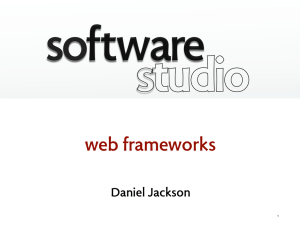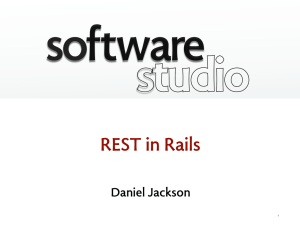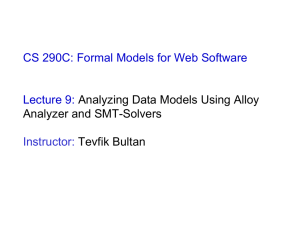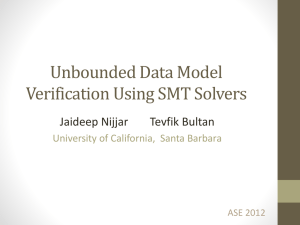Document 13512533
advertisement
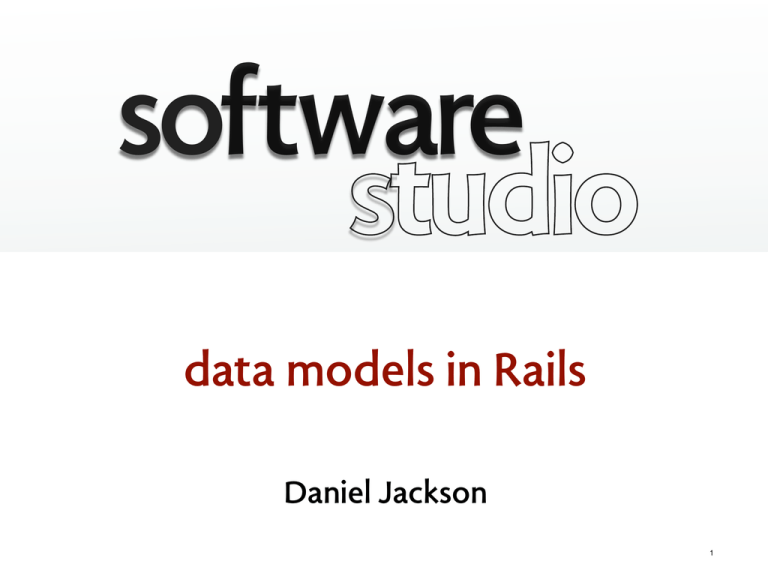
software
studio
data models in Rails Daniel Jackson 1
schema management
schema
› like a type decl for a database
› lists tables and columns
writing a schema in SQL
› schema is created using CREATE TABLE operations what if schema changes after deployment?
› make a new schema
› lose all data in database
› reimport data
2
migrations
class CreateProducts ActiveRecord::Migration
ActiveRecord::Migration
def up
create_table :products d |t|
|t|
t.string :name
t.text :description
t.timestamps
end
end
def down
drop_table :products
end
end
idea
› programmer doesn’t write schema
› instead, writes incremental changes
migration
› an incremental change to the schema
› just a Ruby class with code to modify the schema
› methods to make (up) and rollback (down) change
3
editing schemas
$ rails generate model Product name:string description:text
to create a table
› make a migration class (by hand, or with generator as above)
› run rake db:migrate
to change a table
› run rake db:rollback
› edit the migration
› run rake db:migrate
or
› create a migration for the edit
› run rake db:migrate
4
object relational mapping
class Product
name: “787”
description: ““new ...batteries”
id
name
description
1
“787”
“new dreamliner with excitable batteries”
2
“747”
“long haul aircraft for 400 passengers”
table products
5
model declarations
class Product end
ActiveRecord::Base
ActiveRecord::Base
class declaration
› created with migration by rails generate model
› need not mention columns
mass assignment
› a security vulnerability
› mark assignable columns with attr_accessible
http://www.example.com/user/signup?user[name]=ow3ned&user[admin]=1
params[:user] # => {:name => “ow3ned”, :admin => true}
def signup
@user = User
User new(params[:user])
end
class User ActiveRecord::Base
ActiveRecord::Base
attr_accessible :name
end
6
using models
# Create a new product object
p = Product.new(:name => "787", :description => "dreamliner")
# Modify a product object
p.description = "bad dream liner"
# Save object as tuple in database table
p.save
# Find the product with primary key (id) 3
p = Product.find(3)
7
associations
can now write: customer.orders
class Customer
class Order
date: Feb 19, 2013
customer:
name: “Alice”
orders:
array
[0]:
id
name
id
date
customer_id
1
“Alice”
1
Feb 20, 2013
1
2
“Bob”
2
Feb 19, 2013
1
table customers
table orders
8
declaring associations
class Order ActiveRecord::Base
ActiveRecord::Base
belongs_to :customer
end
class Customer < ActiveRecord::Base
has_many :orders # note pluralization!
end
class CreateOrders < ActiveRecord::Migration
def up
create_table :orders do |t|
|t|
t.references :customer
end
end
def down
drop_table :orders
end
end
9
association types
has_many + belongs_to
› many-to-one relationship
› foreign key goes in table for class with belongs_to decl
has_one + belongs_to
› one-to-one relationship
› foreign key goes in table for class with belongs_to decl
has_and_belongs_to_many x 2
› many-to-many relationship
› need an extra ‘association’ table
Rails guide
› provides examples (but sadly lacks details and clarity)
10
MIT OpenCourseWare
http://ocw.mit.edu
6.170 Software Studio
Spring 2013
For information about citing these materials or our Terms of Use, visit: http://ocw.mit.edu/terms.
